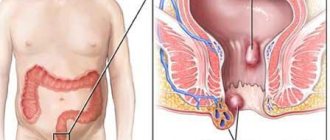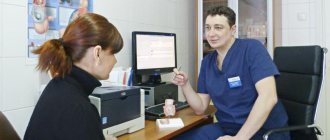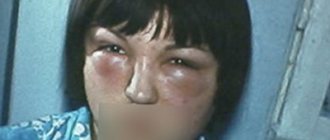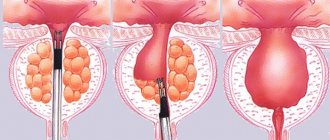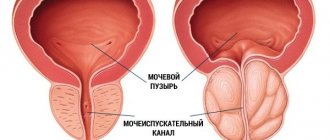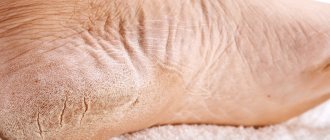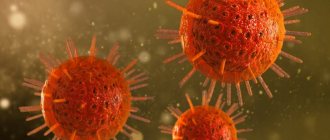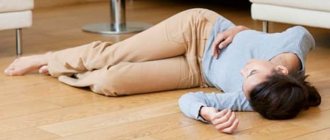Hemorrhoids are a vascular disease in which dilation of the hemorrhoidal veins of the rectum is observed, causing the formation of characteristic hemorrhoids that cause pain and bleeding in patients.
Diagnosis of hemorrhoids is not difficult: more than 90% of cases are determined during a digital examination of the anus and do not require the use of instrumental research methods.
Why are hemorrhoids more common in men than in women?
Hemorrhoids are a pathological process associated with thrombosis, inflammation, and tortuosity of the cavernous veins that form nodes (bumps) around the rectum. It is observed three times more often in men than in women. This is not due to the peculiarity of the body of the stronger sex, but to a frivolous attitude towards one’s own health. So the main causes of hemorrhoids in men are:
- passive lifestyle;
- poor nutrition, obesity;
- addiction to alcohol and cigarettes;
- regular lifting of weights;
- chronic constipation and frequent diarrhea;
- life in stress;
- genetic predisposition.
Many patients are in no hurry to consult a doctor because of the sensitivity of the problem or lack of time, so in most men the disease is detected in the later stages, which greatly worsens the prognosis for recovery.
Diagnosis of hemorrhoids
An examination by a coloproctologist involves complex procedures, among which it is worth noting an examination of the rectum. Upon examination, external hemorrhoids can be identified, and by carefully spreading the edges of the external anal sphincter, internal nodes can be identified. Using a digital rectal examination, which should be carried out in all cases, except those when there is an exacerbation of the process, it is possible to establish the presence of compacted hemorrhoids, the tone of the anal sphincter, and identify concomitant diseases of the rectum. To establish that hemorrhoids have come out, the patient is asked to strain. The doctor must also perform a sigmoidoscopy. A thorough examination of the patient allows us to exclude anal fissure, paraproctitis, polyps and rectal cancer.
Types of pathology
Depending on the location of the nodes, hemorrhoids in men are divided into:
- Internal, in which the cavernous veins become inflamed inside the anal canal.
- External, characterized by deformation and hypertrophy of the saphenous veins below the rectal region.
- Combined, combining internal and external forms of the disease.
If treatment is not carried out for a long time, the inflammatory process becomes chronic, periodically exacerbating against the background of negative factors (eating spicy food, physical overexertion, etc.).
Causes of the disease
Experts believe that the source of hemorrhoids is a change in local blood circulation due to weakening of muscles and veins. Provoking development factors include:
- food – spicy, salty, smoked, fried;
- bad habits – smoking, alcohol abuse;
- genetic predisposition;
- obesity and physical inactivity;
- hard physical labor;
- prostatitis, adenoma;
- liver pathologies, neoplasms;
- psycho-emotional stress.
Age-related changes also play a significant role in the occurrence of hemorrhoids.
How does the disease progress?
At the initial stage, the symptoms of hemorrhoids in men do not cause significant discomfort. There is a slight burning sensation in the anus, short-term itching. Subsequently, small bumps form, which increasingly hurt, swell and bleed after defecation. When lifting weights, they can fall out, and can also be easily set back with the help of your fingers.
Later, the disease is complicated by constant discomfort, swelling, redness of tissues, and pain. The nodes grow, swell, and fall out not only during physical activity, but also when coughing and sneezing, almost always remaining outside. In advanced stages, bleeding occurs with every bowel movement, causing excruciating pain.
Important! If hemorrhoids worsen, the symptoms in men are especially pronounced. They increase every day, which can lead to pinching, thrombosis, node necrosis, paraproctitis, and sepsis.
Stages
The classification involves the following stages of the pathological process :
- Stage I. Periodic pain, the appearance of blood and impurities from the rectal canal, which can be noted on stool or toilet paper.
- Stage II . Hemorrhoidal cones fall out during bowel movements or physical activity, but are reduced spontaneously or manually.
- Stage III . The prolapsed lumps cannot be reduced, the pain is constant and difficult to relieve with medications. Bleeding becomes regular.
- Stage IV . The patient practically cannot sit - this position causes pain. Prolapsed hemorrhoids cannot be reduced.
At stages I and II, treatment is limited to conservative therapy . For complicated or advanced hemorrhoids, the main treatment is surgical.
Treatment options
You can find out which doctor treats hemorrhoids in men at your local clinic. This problem is mainly dealt with by a surgeon or proctologist. Therapy is based on the following principles:
- lifestyle and nutrition correction;
- use of medications for hemorrhoids in men and women;
- the use of surgery.
How to treat hemorrhoids in a man depends on the stage of the disease. If the bumps are small, use venotonics, anti-inflammatory, painkillers in the form of ointments, rectal suppositories, tablets.
Surgical intervention is carried out to remove nodes by ligation, sclerotherapy, coagulation, laser method, and the use of liquid nitrogen. In particularly advanced cases, they resort to hemorrhoidectomy (removal of hemorrhoidal veins) and Longo's operation (resection of lumps in the mucous-submucosal layer of the rectal canal with subsequent suturing of the wound).
Internal hemorrhoids - symptoms and treatment
Treatment is generally divided into operative and non-operative.
Non-surgical treatment can also be divided into conservative and minimally invasive.
1. Conservative therapy: this includes symptomatic treatment with suppositories, ointments, venotonics and, if necessary, anti-inflammatory therapy and the use of painkillers. When choosing drugs, doctors are based on the patient’s complaints - in accordance with them, various types of suppositories, ointments or tablets can be prescribed - with an analgesic effect, healing or to stop bleeding.
Important: self-medication may be chosen incorrectly, may not have the desired effect, and may also worsen the patient’s well-being. That is why if you have any symptoms of hemorrhoids, you need to see a doctor!
2. Minimally invasive treatment of hemorrhoids - is widely used all over the world and has proven itself successfully. Minimally invasive techniques include: ligation of nodes with latex rings, sclerosis of hemorrhoids (including using ultrasonic cavitation), their disarterization using Dopplerography, infrared coagulation, laser vaporization.
- Sclerosation of hemorrhoids
This method is applicable in the initial stages of hemorrhoids, when the disease manifests itself mainly as bloody discharge from the anus. But the technique is sometimes used at stages 2–4 of hemorrhoids as an addition to the main type of therapy.
The essence of the procedure: a special sclerosing drug (Fibrovein or Ethoxysclerol 3%) is injected into the hemorrhoids using an anoscope and a syringe, which affects the vessels in such a way that aseptic inflammation occurs in them, they stick together and are subsequently replaced by connective tissue. As a result, the vessels heal completely, bleeding stops, and the hemorrhoidal node significantly decreases in size. If necessary, the procedure can be rescheduled.
- Latex ring ligation (used since 1968)
This is the most popular minimally invasive method for treating hemorrhoids. Indicated for patients with prolapsed hemorrhoids. Suitable for patients with a more advanced stage of the disease, the procedure is effective and long-term recovery is not required. It is the method of choice for those who are contraindicated for surgical intervention due to concomitant pathology.[8]
The essence of the method: a latex ring is put on the stem of the hemorrhoidal node, the blood flow in the node stops. The node dies and comes out along with the ring during defecation - this happens 2-3 days after the manipulation. Depending on the stage of the disease and the size of the node, 3 or more rings can be applied to achieve the greatest effect. The interval between procedures is 1–2 weeks, depending on the patient’s well-being. The procedure is painless, but may cause discomfort and a feeling of a false urge to go to the toilet. The sensations can last from 15 minutes to several hours and resolve on their own or after taking painkillers.
The rings are made of environmentally friendly rubber, which is absolutely harmless. It is elastic and hypoallergenic.
- Infrared photocoagulation (began to be used since 1989).
Used in the treatment of hemorrhoids with bleeding. As a separate technique, it is ineffective; in our clinic, doctors use it when touching up sites after ligation and other minimally invasive techniques, during pregnancy, in order to stop bleeding.
For infrared photocoagulation, a photocoagulator with a special tip is used. It is brought to the source of bleeding and, by pressing a button, the vessels are “welded.” The duration of the procedure depends on the size of the bleeding area. On average, coagulation lasts up to 3 seconds. The wounds heal in 1–2 weeks.
- Desarterization of hemorrhoids under Doppler control
A method of treating hemorrhoids that is innovative, effective, painless and does not take much time. To perform the procedure, you need equipment with a Doppler sensor (HAL-RAR or Angio-1), with which the arteries that feed the hemorrhoids are detected. Each identified artery is stitched with a special absorbable thread and bandaged. One procedure allows you to ligate from 4 to 8 arteries. In the 3rd–4th stage of hemorrhoids, the second stage of the operation is performed - mucopexy or lifting: fixation of prolapsed hemorrhoids with additional wrapping sutures. All threads after surgery dissolve within 1–3 months. The technique is performed under any type of anesthesia, most often local or regional.
Desarterization is possible at any stage of the disease, but is more effective at stages 1–2 of the disease
- Ultrasonic sclerosis of hemorrhoids
This method combines ultrasonic cavitation and sclerotherapy of the hemorrhoid. The sclerosing substance, under the influence of ultrasound, enters the inflamed hemorrhoidal node at a higher speed, significantly enhancing the effect of the procedure and bringing it closer to traditional surgery. Ultrasound treatment of the damaged node occurs using the Proxon or Skleroson devices.
Cons: high risk of bleeding after manipulation.
- Laser vaporization of hemorrhoids
This bloodless procedure uses heat from a laser to painlessly remove internal and external hemorrhoids. The procedure is carried out using a laser beam, which carefully cuts and cauterizes the tissue.
The laser is able to get rid of hemorrhoids at any stage of the disease, removing both external and internal nodes, regardless of the depth of their location. Laser vaporization can be done even in the presence of thrombosis of hemorrhoids. The doctor uses a laser to burn out the internal node from the inside, and connective tissue forms in its place. External nodes are cut off with a focused laser beam. Since the laser causes the blood vessels to weld together, the procedure takes place without bleeding.[10]
This is the most effective and safe procedure, with no relapses or complications.
Surgical treatment
Hemorrhoidectomy is the oldest and most traumatic method of hemorrhoid removal (performed since 1937), in which hemorrhoids are excised (Milligan-Morgan hemorrhoidectomy). In municipal clinics it still comes first.
This surgical intervention also has significant disadvantages:
- duration of preparation and the operation itself;
- use of anesthesia;
- severe blood loss;
- high traumatic rate;
- complications such as fecal incontinence, anal stricture, bleeding, suture dehiscence and suppuration, fistula formation
- long-term stay on sick leave
- pain syndrome after surgery;
- long-term rehabilitation;
But there are cases when hemorrhoidectomy is the only option to eliminate the disease. There must still be compelling reasons and serious indications for it to be carried out.
Preventive actions
Prevention of hemorrhoids in men is:
- giving up bad habits;
- normalization of the gastrointestinal tract;
- maintaining an active lifestyle;
- strengthening the immune system.
It is important to find out why hemorrhoids appear and, if possible, eliminate the true cause of the development of the pathology. You cannot ignore the symptoms while trying to treat yourself. The longer the inflammatory process drags on, the more expensive and longer the treatment will be.
Remember that there is no need to be afraid, even if hemorrhoids are no longer at an early stage of development.
Hemorrhoids without surgery - it's possible! Make an appointment
Conservative therapy
Treatment involves the use of local and oral medications. Almost all drugs have a complex spectrum of action; a specific type is selected by the doctor in accordance with the complexity of the pathological process and the general condition of the body.
Therapeutic procedures are carried out using:
- anticoagulants and antiplatelet agents - Gepatrombin, Geparoid Zentiva, Lyoton;
- hemostatic agents - Relifa, Troxevasin, Methyluracil, Troxerutin;
- venotonics - Indovazin, Aescin, Procto-Glivenol, Reparil, Venoruton, Essaven;
- anti-inflammatory - Doloproct, tetracycline and syntomycin ointment;
- hormonal - Proctosedyl, Ultraproct, Advantan, Aurobin, Hydrocortisol;
- immunomodulators – Posteinase, etc.;
- astringents - Bezornil, Proctosan;
- antiseptic - Levomekol, ichthyol ointment and Vishnevsky liniment.
Homeopathic medicines can be used during therapy: Aesculus, Phlebodia 600.
In addition to external agents, systemic venotonics may also be included in the regimen. Tablets are prescribed in the primary stages of pathology and as a means of preventing it. With their help, they get rid of venous stagnation, tissue swelling, and suppress the inflammatory process.
Systemic drugs are prescribed if the following indications exist:
- pain syndrome, bleeding;
- constipation - to soften fecal stones;
- the need to prevent the development of the disease or prevent the penetration of secondary infection.
Therapeutic procedures are carried out with Detralex, Venarus, Venoruton, Pilex, etc. During treatment, the patient must give up smoking and alcohol, switch to a balanced diet, not lift weights, and normalize the work and rest schedule.
Traditional methods and their dangers
In the process of searching for ways to cure hemorrhoids without surgery, patients inevitably encounter various traditional methods. You need to treat them very carefully. Consider whether you are ready to apply apple cider vinegar, lemon or onion juice to inflamed hemorrhoids, or insert cloves of garlic into the anus. Before using herbal teas or decoctions, make sure you are not allergic to them. The use of herbs, oils, meals and tinctures can help relieve inflammation, but will not cure varicose veins. As a result, the disease will be masked and will only get worse.
To cure hemorrhoids, be sure to consult a doctor.
How to cure external hemorrhoids?
A distinctive feature of external hemorrhoids is the hemorrhoidal nodes located around the anus. They consist of varicose veins, which are covered with thin skin, prone to frequent inflammation. Typical irritating factors are mechanical trauma from caked feces during constipation and irritation from liquid feces with an incorrect pH during diarrhea. When blood stagnates in the node, a blood clot forms. The skin over it gradually becomes thinner, and the blood clot comes out. Fresh scarlet blood appears behind it. It is external hemorrhoids that cause the most pain to patients. The nodes hurt especially strongly after defecation, during coughing and sneezing. Seizures occur in patients while walking or at rest, when touching the nodes. Treatment consists of relieving pain, normalizing the condition of the veins with medications, and removing nodes (the method depends on the stage of the disease).
Internal hemorrhoids are not painful, but still require treatment
Prevention
The best measures to prevent the development and exacerbation of hemorrhoids, according to proctologists, are proper nutrition, improving bowel function, physical therapy, and careful hygiene.
In order for stool to be regular and have optimal consistency, it is necessary to monitor your diet.
- Consume fermented milk products.
- Eat raw vegetables and fruits rich in fiber.
- Eat small meals 5-6 times a day.
- Don't neglect oatmeal and bran bread.
- Take vitamins A, B, C, E, calcium, magnesium.
- Drink enough water, observing the daily norm of 1.5-2 liters.
- Avoid spicy, fried, fatty, smoked, alcohol.
Take laxatives only when absolutely necessary. Use teas and drinks with a laxative effect with caution, otherwise the intestines will literally “forget how” to work.
To strengthen the walls of blood vessels, take a course of phlebotonic drugs twice a year.
Therapeutic exercise and massage are also very useful because they help improve blood circulation and prevent congestion. If you find yourself in the same position for long periods of time, take regular small breaks to walk around or do at least a few squats. There are also special exercises for the anal sphincter and improving bowel function, but during an exacerbation they should not be done.
It is extremely important to carefully observe hygiene: wash your face every day, change your underwear, clean the anus with a damp cloth (without alcohol or fragrances) after each bowel movement.
How to cure hemorrhoids during pregnancy?
Doctors have to think especially carefully about how to cure hemorrhoids after childbirth or during pregnancy. Many medications are prohibited to be taken during pregnancy and lactation, so most often doctors achieve stabilization of the patient’s condition, eliminate pain, and begin full treatment after the end of lactation.
Lactation consultants have their own point of view on the issue of drug treatment during lactation. They draw women's attention to the fact that many medications are prohibited from taking during pregnancy and lactation due to the fact that their effect on the child has not been thoroughly studied. Therefore, we cannot say unequivocally that all of them bring harm to the child. It may well be that when the appropriate studies are carried out, many drugs will be allowed to be taken. In the meantime, the Ministry of Health prefers to play it safe; women have at their disposal a minimal arsenal of means to solve “delicate” problems.
To treat hemorrhoids during pregnancy, be sure to consult your doctor.
